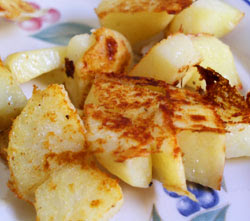 Eggs Baked in Cream, I love thee.
Eggs Baked in Cream, I love thee.
As I was preparing my baked eggs in cream, I suddenly remembered another reference to this recipe in the book Julie & Julia, the story of a woman who cooks every recipe in Julia Child’s Mastering the Art of French Cooking. It was a favorite dish of the book’s author, and she had referred to it as the perfect hangover cure. I looked up Mrs. Child’s recipe for Oeufs en Cocotte, which was slightly more refined than the one I made. She recommends heating the cream first, then dropping the eggs in, and covering it with more cream and a little butter before putting them in the oven. It’s important to set the egg dish in water, “otherwise the intense heat of the over toughens the outside layers of egg before the inside has cooked…The eggs are done when they are just set but still tremble slightly in the ramekins.”
Child recommends cooking them 7-10 minutes at 375 degrees. I left my eggs in a little long and they got over cooked (the yolk was not as runny as I would have liked) but still tasted AWESOME. When it came out of the oven, I garnished it with more salt and some fresh cracked pepper. The cream and the egg white melded together, and become something that transcended a mere egg to taste like the most creamy egg-like thing in existence. I sopped up the creamy-egg-goo with my whole wheat gem, and slurped the rest off a spoon. After finishing the meal with a perfectly ripe orange, I decided that this might have been the best breakfast EVER.
Lunch: Scalloped Potatoes, String Beans, and Cottage Cheese.
The scalloped potatoes were another huge success: the combination of the onions and the milk gave the potatoes an addictive, sweet flavor, and the butter tied everything together. I was literally licking the bottom of my bowl. I would definitely make this again. Hell, I’d take it to a potluck!
The beans I simply blanched and salted, and the cottage cheese came from a regular old Breakstone’s container.
Dinner: Walnut Roast with Chile Sauce, Mashed Potatoes, Radishes.
My second night of making meatless meat was slightly better than the first. I halved this recipe and I used a seasoned bread crumb. It is important to let it sit in the cream and milk for at least 10 minutes. It coagulates into a surprisingly thick goop. When it came out of the oven (40 minutes at 375 degrees) it poofs up on top and looks all brown and yummy. For the chili sauce, I used tomato paste and thinned with a little water in place of “condensed tomatoes.” It was actually good, just a bit strong. I could have thinned it out a little more. Combined with the Walnut Roast…well, it was okay. I ate about half, but it was kind of intense and weird. I don’t think we have a winner yet.
The were no cooking suggested in Ms. Cooper’s book for mashed potatoes, so I made them the classic way, with some butter and a shot of cream. Ditto with the radishes. I ate them in the French fashion, smeared with butter and sprinkled with salt. The fat cuts the tart bite of the radish, and it’s very tastey.
 Walnut Roast. It would be nice to eat a dinner that doesn’t look like kitty catfood barf.
Walnut Roast. It would be nice to eat a dinner that doesn’t look like kitty catfood barf.
On day two, I have to say that these meals are consistently well rounded. Produce plus a starch plus a protein keep me full and give me energy. And my bowels are immaculate!







